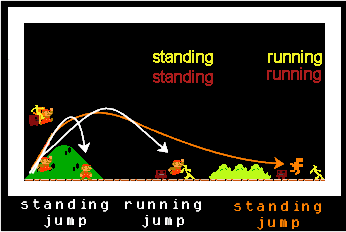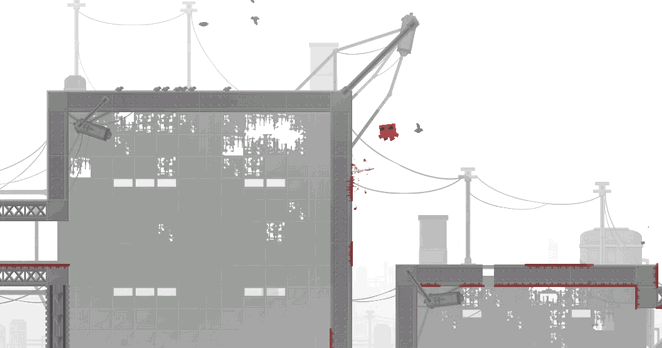Every year or so a game comes along that is preceded by glowing hype. After hearing so many bold statements and promising claims about a game, I realize the only way to get to the bottom of things is to play the game myself. I started the Critical-Gaming Blog by writing an extensive series of essays on BioShock. Despite not liking the game very much, I was able to understand and describe the game citing lots of specific examples. Fast forward 3 years, after breaking down the greatest platforming series Super Mario Bros., I now have the critical-language and the experience to handle any platformer.
The game I'll be serving up (just because Team Meat detests food themed puns) is Super Meat Boy. I mentioned this game throughout my "About That Indie Feel" series, but those mentions don't convey what kind of game Super Meat Boy is. In this analysis I'll fully cover its core design, quotes from the developers, and compare it to a platformer from my past.

Mechanics
Super Meat Boy is a platforming game known for its difficulty. Aside from horizontal movement, Meat Boy only has a RUN and JUMP mechanic. Both are mapped to different buttons making them individual. They're decently dynamic for such simple actions, and the JUMP mechanic is direct allowing players to vary the height of the JUMP by holding the button longer. However, these mechanics aren't completely intuitive. This is to say that there are elements to their design that are contrary to real world interactions (and other platformer interactions for that matter).
Super Meat Boy, like all video games, is an artifice that is not meant to simulate the real world but create an interactive world/system that's convincing and consistent. Still, the familiar concept of inertia or momentum is arbitrarily applied in Super Meat Boy. This is different from being exaggerated or removed altogether. The RUN mechanic affects your horizontal speed on the ground (as you may expect), but it also instantly changes your horizontal speed in the air. Where does this extra force come from? Perhaps this is just a way to give players a little bit more control in the air? After all, the very idea of air control defies physics. Still, in Super Meat Boy players can move on the ground at high speeds and then stop instantly just by letting go of the left or right button. Yet if you change directions while moving you slide to a stop. Furthermore, Meat Boy slides up and down walls with the same upward momentum whether you RUN JUMP or just JUMP. So is Meat Boy super slippery? Or does he have awesome stopping power? Over all this isn't so big of a deal, but players may have a difficult time adjusting to the particular nuances of Meat Boy's mechanics.

There's so much more to Meat Boy's JUMP than this. The high speed increase from the RUN mechanic makes Meat Boy's standing JUMP equivalent to Mario's RUN+JUMP (see image above). And like the Ninja from N and Jumpman (all indie games) the horizontal distance for JUMP is much larger than Mario's. This is most likely due to the nature of designing for a PC screen.
Meat Boy JUMPs at different angles depending on whether or not the RUN button is held. Understanding Meat Boy's variable JUMP angles and arcs is a level of nuance that many will struggle to grasp. Things get even trickier when we consider the WALL JUMP. There are 3 variations to this mechanic. The RUN-WALL-JUMP, WALL-JUMP, and the short hop (quick tap of the JUMP button) WALL JUMP all launch Meat Boy at different angles. Compared to the ninja from N+ or Mario's WALL JUMP from New Super Mario Bros.'s, Meat Boy's mechanics feature more subtle nuances, which can over complicate seemingly simple platforming challenges.
I want to take the time to discuss Super Meat Boy's game speed here because it's mainly driven by player mechanics. The faster a game the more the skill spectrum begins to break down. I've thought about this very carefully, and I've concluded that Meat Boy moves faster than he should for his own good. Or maybe I should say, for our own good. Especially for a game that runs at 30 fps (from what I can tell), very fast moving objects begin to skip across the screen rather than move through it. To put it simply, fast moving elements make it difficult for player to play and the game to calculate collisions.
Meat Boy's super fast horizontal RUN speed and his acceleration in free fall work against the gameplay. With less time to react, players have to think ahead to compensate. This involves memorizing more of game rules thus stressing knowledge skills, which can delay progress, create skill barriers, and reduce the flow zone.
Better sound design would have really helped players really feel the collisions and other Meat Boy interactions. In the retro warp zone levels, Meat Boy has sound effects for his JUMP, landing, and collisions against walls. Because the fast game speed naturally reduces the timing windows for players to act (dexterity) and react (reflex) having a crisp sound design like this throughout the rest of the game would go a long way in helping the player learn the game.

Core Challenge Design
Since the NES, the Super Mario Bros. 2D platforming games have been designed around a counterpoint between 3 layers to create the core challenges; Mario, Enemies, and Level Elements. All three layers work for and against each other to create a very emergent, dynamic system. When you break a brick, you change the platformable environment, which may change incoming-organic-enemy timers or your offensive/defensive opportunities.
The challenges in Super Meat Boy are far less deep, variable, and emergent than Mario's. The crumbling blocks are an example of a level elements that the player can transform like Mario bricks. The homing missiles, Cerberus missiles, laser eyes, and the evil meat demons do have more interplay than any of the other enemy elements in Super Meat Boy, but only a step or two more. Overall, pits, buzz saws, salt streams, and other stationary enemy elements are the most common enemy elements in the game. And because one hit will kill you completely and you can't interact with these enemy elements directly, there isn't a lot of interplay. So it's no surprise that Super Meat Boy's level challenges are pretty strict. The spacings and the timing windows you see are mostly what you get with no emergent surprises or player influenced variation. This isn't an inherently bad thing.
In part 2 I'll cover level design and difficulty design.